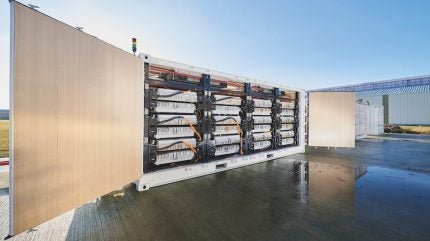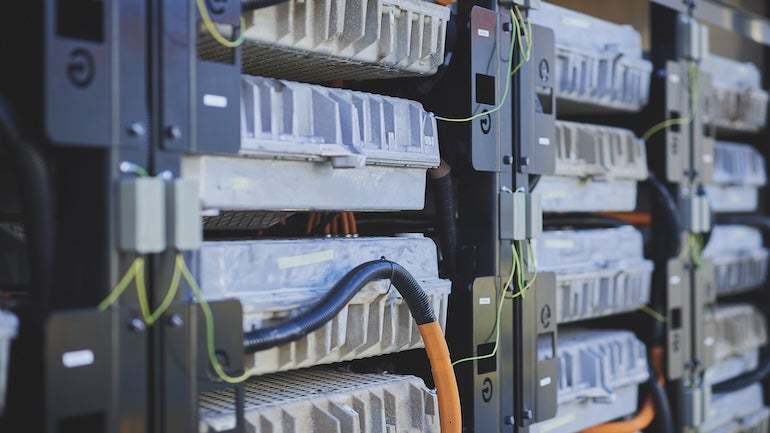
According to a recent report from RenewableUK, the UK’s pipeline of battery projects has grown by two-thirds in the last 12 months, further cementing its role in providing electricity grid flexibility and security. In step, late last year the UK government published its Battery Strategy, setting out its vision for developing a globally competitive battery supply chain. Central to the strategy is the need to accelerate domestic capabilities and secure the critical minerals needed.
While the potential for second life batteries is not well recognised by the strategy, a decade of research and development confirms that they offer a sustainable, low risk and readily available alternative to new batteries for the fast-growing stationary energy storage market.
While exhibiting similar performance capabilities to new batteries, they do not depend on the import of critical minerals. Comprehensive tests show that an EV battery with around 75% capacity or more could be economically repurposed as stationary storage, extending the battery’s useful life by up to 100%.
Safety considerations
Although safety incidents at battery energy storage sites are rare, safety is paramount, and a significant consideration industrywide. Connected Energy’s approach is to only work with OEMs who will collaborate closely with us, sharing data to ensure the highest product safety and performance. Batteries must have “naturally” reached their end of life, rather than have been involved in a collision or ended up as scrap. On receipt, their suitability for repurposing into stationary storage is evaluated by reviewing the history and through a series of health checks and physical inspections.
At present, most second life battery stock considered by Connected Energy for stationary storage comes from fleet vehicles such as vans via automotive original equipment manufacturers (OEMs). There are several practical reasons for this, not least because EV manufacturers are enthusiastically engaged in exploring new avenues to reuse spent batteries, which regulations require to be collected and disposed of. This means large volumes of batteries are increasingly available.
Fleet vehicles typically have excellent traceability with good service history, which provides a baseline of high quality data. Most fleet vehicles also have predictable daily duty cycles and are charged steadily overnight which makes them relatively homogeneous in terms of use and degradation. Altogether this has made fleet vehicle batteries ideal as a basis on which to develop the necessary technologies for a stationary storage solution using second life batteries.
Contrary to early industry expectations, battery degradation has not been as significant as anticipated. Our test data has revealed that under normal operating conditions, most second life batteries offer 80-85% efficiency, with lithium always at the high end, around 90% – not dissimilar to what is experienced in a car.
Similarly, we have now gathered more data on second life battery performance than has existed before, covering a wide range of duty cycles. This is being used to continually improve prediction capabilities and ensure robust safety processes.

Second life batteries in operation
In Connected Energy’s second life stationary storage solution, battery packs are controlled in pairs. Containerised systems consist of between 24 and 100 packs, depending on the minimum system capacity. A control system manages each pair, allowing higher capacity packs to be called upon more frequently so that packs reach the same state of health over time. The system also provides greater levels of dynamism and flexibility, optimising how the batteries are used and monetised.
Nottingham City Council in the UK, for example, has 600 kW of second life stationary storage at their EV fleet depot, which consists of 48 packs. Installed to help transform the site’s energy use, the system stores excess electricity from three on-site solar arrays which is then used later to charge the EV fleet and reduce electricity use during peak times. Additionally, with the flexibility afforded by the system, the site aims to participate in grid services by trading stored electricity, and through vehicle-to-grid services via the 40 bi-directional EV chargers.
Once in operation each pack is monitored and controlled remotely 24/7. As the peak power requirements of an EV are much more demanding than what is required of stationary storage, the packs are charged and discharged at a rate about three to four times lower than in peak EV use, making for gentler operation and lower degradation.
Power can also be rebalanced across the system to minimise the batteries being subjected to a prolonged high state of charge, thereby increasing efficiency overall.
Data from the packs, including operating temperature, charge, efficiency and exception alerts, are analysed to assess the system’s health and machine learning is used to identify anomalies, trends and relationships between the variables. The results inform real time operation to enhance performance as well as identifying preventative operation and maintenance strategies to optimise the system. The data is also used to update the models and assumptions to improve future systems and business cases.
Finally, the OEM’s original battery management system remains in use too – the same system that is trusted by millions of EV users to get their families and goods from A to B – to ensure continued safety.
The future of second life batteries
The forthcoming introduction of the Battery Passport in the EU in 2027 will go some way to improving the data available from batteries, with statistics on performance and durability expected to be made available that will support better decision making at the end of a battery’s first life.
The industry is also likely to experience a move away from transactional relationships as the EU Battery Regulation Amendment begins to have an impact. With the goal of achieving sustainable battery lifecycles, battery manufacturers will be increasingly interested in novel ways to extend battery lifecycles, particularly given the current lack of battery recycling facilities that is impacting the supply chain UK and EU-wide. This could see battery manufacturers increasingly working collaboratively with stationary storage providers, potentially retaining ownership of their batteries and receiving a revenue from their use.
As a market for second life batteries develops, we are likely to see increased engagement from large fleet owners, who will be interested in maximising the value that they can get from the sale of their batteries by balancing use and degradation.
The potential for using second life batteries in stationary storage is hugely exciting, with the next five years set to see a significant increase in the volume of batteries reaching the end of their first life along with the benefits of a more supportive policy environment. Offering a comparable alternative to new batteries, second life storage helps to solve several of the UK’s key energy challenges all at once; from the need for grid storage to support greater renewables penetration and improve energy security to providing additional power capacity to support the electrification agenda.
Over the past decade, Connected Energy has developed the technologies needed to exploit this opportunity and is now poised to scale up, supported by new industry partnerships, finance and business models.






